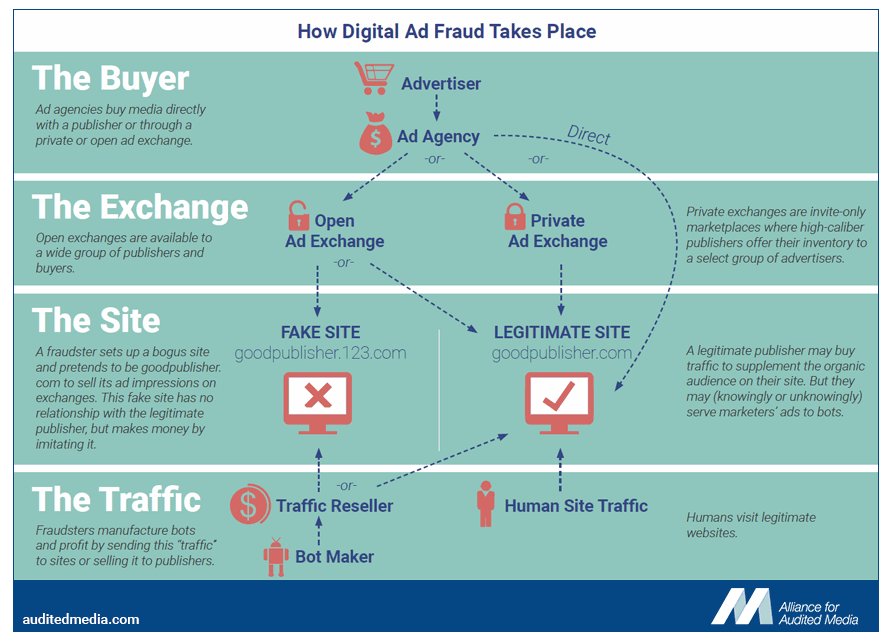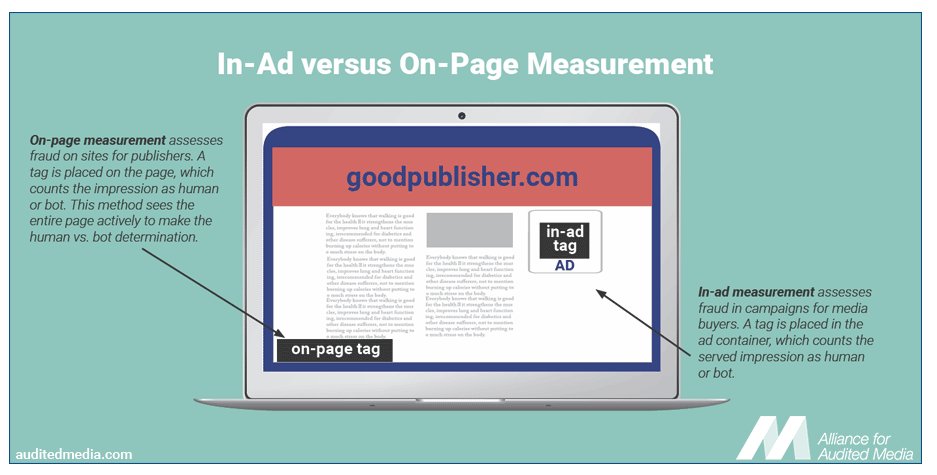Tom Drouillard, CEO, President and Managing Director, Alliance for Audited Media Digital ad fraud estimates range from $6 billion to $16 billion annually, and the current supply chain structure makes it easy and attractive to commit ad fraud with little chance of retribution. Publishers, marketers, agencies, and technology suppliers are frustrated. Trust is at an all-time low. The industry is nearing crisis stage as marketers are seriously questioning, rethinking and redoing their digital investments. Why should newspapers care and be involved in preventing digital ad fraud? Because good publishers with good business practices and human audiences are losing money to fraudsters. We explain three basic facts about ad fraud so you can better understand the issues and how they may be impacting your business.
Truth #1: Ad Fraud Occurs on Both Fake and Legitimate Websites. Let’s look at how it takes place.
- Fake-Site Fraud: Marketers’ ads are placed on fraudulent websites with content that is pirated, fake or non-existent, and displayed to bots.
This occurs when the fraudster creates a bogus website, plugs into programmatic exchanges, buys traffic for the site, sells and displays the ad impressions, and collects the money for doing so. The fraudster steals ad dollars that were supposed to go to real publishers, like newspapers.
- Legitimate-Site Fraud: Marketers’ ads are placed on legitimate websites with real content and displayed to bots.
This occurs most often when a legitimate publisher’s organic audience is supplemented with third-party traffic to fulfill demand. Often this is completed through the purchase of traffic that may appear to be human but is in fact illegitimate bot traffic.

Fraudsters create bots to commit both fake- and legitimate-site fraud. But fraudsters do not covertly send their bots to legitimate publishing sites in substantial numbers because they don’t make money that way. Instead, they make money by selling manufactured bots as “traffic” to publishers. All newspapers want to drive traffic to their sites. But it’s important for publishers to understand that it’s possible that paid traffic is not human traffic.
Truth #2: Illegitimate Traffic Sourcing is the Main Cause of Fraud Traffic sourcing is any method newspapers use to acquire visitors through third parties. There are two main types:
- Legitimate marketing activity is when a publisher engages in audience acquisition methods that drive people to their site such as running sponsored posts on social media, distributing an email newsletter or running a contest.
- Illegitimate traffic sourcing occurs when a publisher pays a traffic supplier for a fixed number of visits to their website. Publishers often buy traffic at the end of the month or quarter to “make their numbers.” Traffic sellers often promise the publishers that the traffic is human and will pass through all ad fraud detection filters.
This type of traffic is likely robotic. The publisher might not know that this traffic is robotic because it may appear human in their fraud detection reports. It might also appear to be human traffic in the advertiser’s fraud detection reports. The whole advertising economy relies on this practice today, and it is the main form of digital ad fraud as was outlined in the
2017 fraud study published by the ANA/White Ops.
Truth #3: Ad Fraud Measurement is Used to Transact but Does Not Minimize Ad Fraud Ad fraud detection services are an important part of how the market transacts today because they add friction to combat the fraudsters. These services measure and filter non-human traffic. Multiple vendors with proprietary methods and technical measurement limitations compound the confusion surrounding ad fraud. To understand the limitations, consider the two techniques used to measure ad fraud today: in-ad and on-page measurement. Advertisers and agencies use ad fraud detection vendors to measure fraud in their campaigns. They use in-ad measurement, which means a tag (computer code) is placed in the ad container. There are two problems associated with in-ad measurement. The first problem is ad fraud detection vendors all have proprietary methods and calculate measurement differently. The second problem is that in-ad measurement can only see what is happening within the ad container, not the other activity on the page. Because the ad is limited to a small area of the entire page, there are fewer data points that the tag can collect to determine whether the exposure was a human or bot. Publishers also use fraud detection vendors to measure fraud on their sites and face the same issues of multiple vendors and methods. Publishers use on-page measurement, which places a tag on the page where an ad is displayed. This produces a more accurate measurement because it can detect more engagement on the entire page such as scrolling and clicking. This is the reason that an advertiser’s in-ad measurements are normally at odds with a publisher’s on-page measurements.
When you layer technical limitations of fraud measurement and proprietary methods from multiple vendors with the practice of purchasing bot traffic that is engineered to pass fraud detection, it is clear why there is frustration at all sides of the market. The measurements the industry relies on for transaction purposes deliver a false sense of security.
 Confronting the Truth
Confronting the Truth By looking deeper into each of these topics and the business of fraud—how the money is made and how it leaves the ecosystem—it’s clear that ad fraud is conquerable. The war on fraud is winnable. Publishers with quality, human audiences need to raise their hands and get the credit they deserve. Learn about how AAM is helping quality publishers stand out in:
Three Truths That Help Confront the Digital Ad Fraud Crisis.
Tom Drouillard oversees the Alliance for Audited Media, a media assurance organization located in the U.S. and Canada. Under his leadership, AAM has developed new digital auditing services, introduced streamlined media-reporting tools, and implemented a strategic focus on product development and client solutions.
 Fraudsters create bots to commit both fake- and legitimate-site fraud. But fraudsters do not covertly send their bots to legitimate publishing sites in substantial numbers because they don’t make money that way. Instead, they make money by selling manufactured bots as “traffic” to publishers. All newspapers want to drive traffic to their sites. But it’s important for publishers to understand that it’s possible that paid traffic is not human traffic. Truth #2: Illegitimate Traffic Sourcing is the Main Cause of Fraud Traffic sourcing is any method newspapers use to acquire visitors through third parties. There are two main types:
Fraudsters create bots to commit both fake- and legitimate-site fraud. But fraudsters do not covertly send their bots to legitimate publishing sites in substantial numbers because they don’t make money that way. Instead, they make money by selling manufactured bots as “traffic” to publishers. All newspapers want to drive traffic to their sites. But it’s important for publishers to understand that it’s possible that paid traffic is not human traffic. Truth #2: Illegitimate Traffic Sourcing is the Main Cause of Fraud Traffic sourcing is any method newspapers use to acquire visitors through third parties. There are two main types:  Confronting the Truth By looking deeper into each of these topics and the business of fraud—how the money is made and how it leaves the ecosystem—it’s clear that ad fraud is conquerable. The war on fraud is winnable. Publishers with quality, human audiences need to raise their hands and get the credit they deserve. Learn about how AAM is helping quality publishers stand out in: Three Truths That Help Confront the Digital Ad Fraud Crisis. Tom Drouillard oversees the Alliance for Audited Media, a media assurance organization located in the U.S. and Canada. Under his leadership, AAM has developed new digital auditing services, introduced streamlined media-reporting tools, and implemented a strategic focus on product development and client solutions.
Confronting the Truth By looking deeper into each of these topics and the business of fraud—how the money is made and how it leaves the ecosystem—it’s clear that ad fraud is conquerable. The war on fraud is winnable. Publishers with quality, human audiences need to raise their hands and get the credit they deserve. Learn about how AAM is helping quality publishers stand out in: Three Truths That Help Confront the Digital Ad Fraud Crisis. Tom Drouillard oversees the Alliance for Audited Media, a media assurance organization located in the U.S. and Canada. Under his leadership, AAM has developed new digital auditing services, introduced streamlined media-reporting tools, and implemented a strategic focus on product development and client solutions.
Comments
No comments on this item Please log in to comment by clicking here